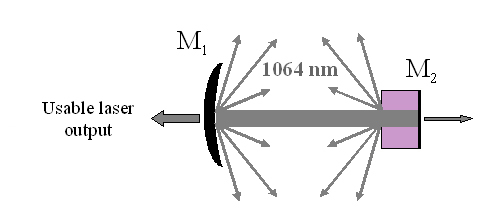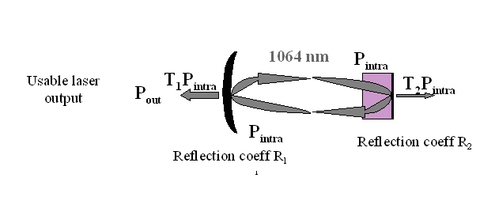
Output power formula
Beyond the oscillation threshold, the power at 1064 nm is no longer negligible. To simplify the process, each pump photon beyond the oscillation threshold is assumed to become a laser photon and leave the cavity. To do this, the photons must either go through the output mirror or experience passive losses in the cavity. Figure E11 shows where the different laser outputs are situated. As seen in the photo of Figure E9, there are losses by diffusion on the mirrors and globally over all the interfaces. These losses, as well as the residue of the transmission through the mirror M2, cannot be used: they are the so-called passive losses. The only useful part of the beam is that which leaves via M1. The intensity of this beam is called the output power or Pout.

As explained in the section “Power of the pump at the lasing threshold”, all the passive energy losses are grouped together in the value for the transmission of the output mirror M2. This value T1 is given by: T1=1-R1 and T2 is defined by T2=1-R2. If
 is the power circulating inside the cavity, then the total power emitted at 1064 nm,
is the power circulating inside the cavity, then the total power emitted at 1064 nm,
 ,is given by:
,is given by:
The output power,
so compared to the total emitted power,

Above the laser threshold, all the pump photons are assumed to be absorbed by the Nd:YAG crystal and then transformed by stimulated emission into laser photons. The number of pump photons converted per second is equal to:
If the number of laser photons emitted is equal to
Finally, the output power can be expressed thus: